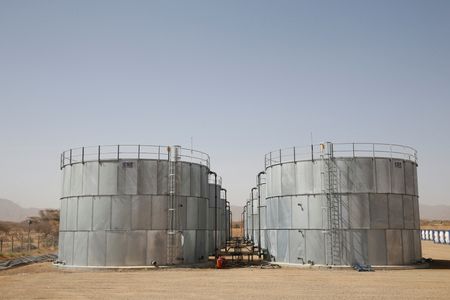By Riham Alkousaa and Sarah Marsh
BERLIN (Reuters) – Germany may face months of uncertainty after the CDU/CSU conservative bloc won the national election but with no clear option for forming a government amid a fragmented political landscape.
With as many as seven parties possibly entering parliament, the conservatives, on course for just under 30% of the vote, will need to form a coalition.
The composition of the coalition will depend on whether the pro-business Free Democrats (FDP) and leftist Sahra Wagenknecht Bewegung (BSW) hovering around the 5% threshold needed to take seats, enter the parliament.
Here is a summary of the most likely coalitions and the compromises that will be necessary to reach agreement, according to early projections of the results from the ZDF broadcaster.
GRAND COALITION (CDU/CSU and Social Democrats)
A so-called grand coalition of the two big centrist parties, the CDU/CSU and Chancellor Olaf Scholz’s centre-left Social Democrats (SPD) has been seen as the most likely election outcome but according to early projections at 293 seats combined, the two parties are short of a 316-seat majority.
If final results push the FDP and BSW out of parliament, a grand coalition would be possible.
The SPD and CDU/CSU have already governed together four times since World War Two – three times under the leadership of former conservative Chancellor Angela Merkel.
Merz, however, has moved his bloc further to the right, taking a tougher stance on migration than Merkel and a more pro-market position on the economy.
The CDU/CSU wants broad tax cuts while the SPD wants to raise taxes for high-income earners and revive a wealth tax. That means both could struggle to agree on deeper reforms, except a possible easing of the debt brake.
Probability: 60% according to the Eurasia Group.
KENYA (CDU/CSU, Social Democrats, Greens)
Scholz’s three-way coalition, the first in Germany in decades, collapsed due to infighting last November. But Merz may be forced to find two partners if the FDP and BSW reach the 5% threshold, fragmenting the seat allocation.
The CDU/CSU, SPD and Greens could decide to form a so-called “Kenya” coalition, as their colours match those of the Kenyan flag. This coalition is currently one of the few mathematically possible to achieve a majority, at 374 seats if the smaller FDP and BSW remain in the parliament.
Such coalitions have only occurred rarely at state level. While the conservatives and the Greens share some foreign policy views such as the need to provide more decisive support to Ukraine, they lie far apart on domestic policy and in particular on migration.
Merz has repeatedly criticized the Greens party leader Robert Habeck as a “failed” economy minister, ruling out extending his tenure.
Probability: 10% according to the Eurasia Group.
GERMANY (CDU/CSU, Social Democrats, Free Democrats)
Another unlikely three-way combination could be the “Germany” coalition of CDU/CSU, SPD and FDP, named after the black, red and gold colours of the national flag. Such a coalition would secure a slim majority with 326 seats.
It would be hard for the FDP and SPD to find common ground as a row over the budget between Scholz and FDP head Christian Lindner, who was then finance minister, led to the collapse of the three-way coalition and triggered snap elections.
Probability: 10% according to the Eurasia Group.
MINORITY GOVERNMENT
Some German states have had minority governments which seek different partners for each piece of legislation.
However, this has never happened at the start of a new legislative period on a federal level, only after a coalition has imploded, due to fears of the instability it could create.
Some politicians though are urging parties to consider this option given how complicated it is becoming to form a coherent coalition.
Merz himself said in a 2017 interview that parties should not exclude the possibility of a minority government, although he has not commented on the issue lately.
WHAT ABOUT THE AFD?
Mathematically, the conservatives and the far-right Alternative for Germany (AfD) make a majority of 318 seats but all other parties have ruled out forming a coalition with the AfD. The strength of the party is another factor set to complicate coalition building and securing a parliamentary majority.
(Reporting by Riham Alkousaa, Andrey Sychev and Sarah Marsh; Additional reporting by Andreas Rinke; Editing by Alexandra Hudson, Hugh Lawson and Keith Weir)











